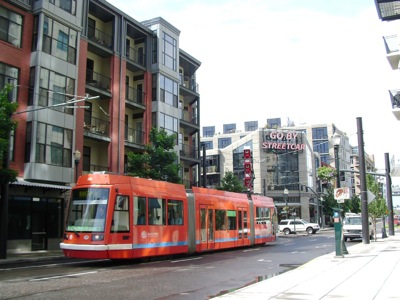 Yet more proof — the $470m. North line that needs $70 million in future property tax dollars to get built came first — that our $9b. transit plan cannot be funded with a half-cent transit tax. Now the Charlotte Business Journal reports that the city is working up numbers for $400 million worth of tax increment financed streetcars.
Yet more proof — the $470m. North line that needs $70 million in future property tax dollars to get built came first — that our $9b. transit plan cannot be funded with a half-cent transit tax. Now the Charlotte Business Journal reports that the city is working up numbers for $400 million worth of tax increment financed streetcars.
Of course, the primary goal has nothing to do with transportation. It is all about re-development. Big frickin’ surprise.
Except the joke is on the Charlotte city council and planners. Their “Portland model” does not work, as has been repeatedly demonstrated. Randal O’Toole explains:
Streetcars are so insipid that their advocates barely even claim that they have anything to do with transportation. Instead, they are supposed to stimulate economic development — though the only evidence of that is from Portland, which just happened to offer hundreds of millions of dollars of subsidies to developers along its streetcar line. Especially when you consider that many of those subsidies went to the construction of parking garages, can anyone really think that the streetcar had anything to do with the developments?
Why, yes. Meet John Lassiter:
“We know that the streetcar will stimulate revitalization in those areas — and benefit the other places it goes,” says John Lassiter, chair of City Council’s economic-development committee. “I am very supportive of trying to get that under way faster, but it’s going to take some crafty work to find funding from other legislative bodies, too.”
See? John Lassiter just “knows” that streetcars will be a boon for Charlotte. Funny, not even Portland’s own transit agency “knows” that.
More O’Toole:
Intriguingly, TriMet admits that “light rail does not by itself promise redevelopment,” but because light rail provides “clean, quiet access” it allows development that is more “pedestrian oriented.”
These are all fine words, but the bottom line is that no transit-oriented or pedestrian-oriented development took place along Portland’s light-rail line for 10 years after the city had zoned it for just such development. Only after the city began subsidizing it did such development take place.
“The City of Portland has used tax incentives to help overcome redevelopment hurdles,” says TriMet, “but recently recognized that the transit-oriented development incentive has served its purpose and eliminated that incentive.” TriMet is referring to the approximately $100 million of 10-year waivers of property taxes that Portland offered to high-density residences along the light-rail line.
But TriMet ignores the $1.2 billion in tax-increment financing that Portland is offering to developers along the rail lines — or similar direct subsidies offered by Portland’s suburbs, including Gresham and Beaverton. These “incentives” have not been eliminated and, without them, little or no transit-oriented development would take place. … “Light rail and streetcar investment has been matched with more than $8 billion in adjacent new development,” claims TriMet. This number includes the cost of every new development that happens to be near the rail lines, whether or not they are transit oriented, whether or not they received other subsidies, and whether or not they have anything to do with the rail lines.
Much of the $8 billion is government buildings in downtown Portland. Some of it is downtown parking garages (like the one mentioned above). Almost none of it was clearly inspired by the rail lines.
In short, rail transit has generated no new development in Portland. All it has generated is more subsidies to development.
Oh, and Center City Partners honcho Michael Smith is smoking dope if he thinks there are federal grant possibilities to help fund Charlotte’s streetcar dreams. The Federal Transit Administration will not even fund Portland’s streetcars because they cost too much.
Closer to home, even the $463 million South Blvd. light rail line required an additional $70m. in city-bought infrastructure improvements along the line. There is nothing magical spending hundreds of millions on trains to “revitalize” a corridor. Nor is there wonder to government spending $40 million on a trolley line before that, $16 million in direct city subsidy to the Westin hotel, $150 million on a convention center, a $155 million convention center expansion/NASCAR Hall of Fame, a $43 million ImaginOn, and $265 million on an Uptown Arena. When you spend lots of money, sure enough, you’ve spent lots of money.
In a final twist of illogic, city councilman Wayne Turner takes the arena expensive and draws exactly the wrong conclusion about $400m. worth of streetcars:
Some may blanch at the idea of a project with a $400 million price tag, but the streetcar will only grow costlier the longer it sits on the shelf, Turner says.
He says those put off by the streetcar’s cost should compare it with the $265 million publicly funded arena uptown. “That was the price tag for building our new arena, which most of our own citizens can’t use.”
Obviously. You were warned last fall that this was coming, Charlotte. Now your property tax dollars will go to build trains instead of hire cops or fix potholes. As we told you would happen, TIF projects for trains will eat into general fund revenues and mandate property tax hikes.
Ta-da!
Bonus Observation: And so it begins. County sales tax revenues are coming in flat, meaning years of reckless spending may be coming to halt. It is a county election year, which general means tax hikes are off the table. Besides, the county has the property tax reval as its hole card for 2009.
Super Irate Bonus Observation: City manager Curt Walton was emailed precisely this question on additional funding for transit back in August — twice in fact. He never responded. Now we know why.
